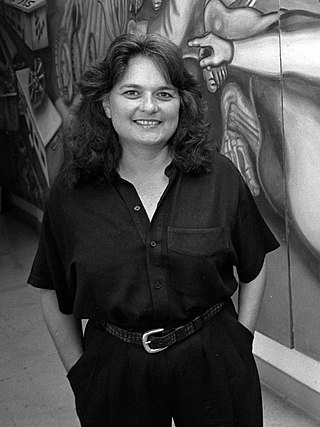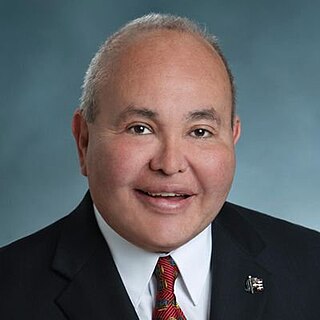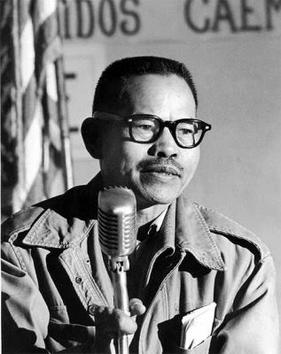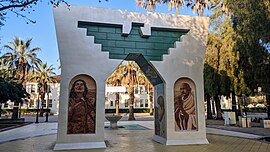
Cesario Estrada Chavez was an American labor leader and civil rights activist. Along with Dolores Huerta, he co-founded the National Farm Workers Association (NFWA), which later merged with the Agricultural Workers Organizing Committee (AWOC) to become the United Farm Workers (UFW) labor union. Ideologically, his worldview combined leftist politics with Catholic social teachings.

The United Farm Workers of America, or more commonly just United Farm Workers (UFW), is a labor union for farmworkers in the United States. It originated from the merger of two workers' rights organizations, the National Farm Workers Association (NFWA) led by César Chávez and Dolores Huerta and the Agricultural Workers Organizing Committee (AWOC) led by organizer Larry Itliong. They allied and transformed from workers' rights organizations into a union as a result of a series of strikes in 1965, when the Filipino American and Mexican American farmworkers of the AWOC in Delano, California, initiated a grape strike, and the NFWA went on strike in support. As a result of the commonality in goals and methods, the NFWA and the AWOC formed the United Farm Workers Organizing Committee on August 22, 1966. This organization was accepted into the AFL–CIO in 1972 and changed its name to the United Farm Workers Union.

Colegio Cesar Chavez was an American college-without-walls in Mount Angel, Oregon. The college was named after Mexican American civil rights activist César Chávez. Colegio was established in 1973 and closed in 1983. Colegio was the first accredited, independent four-year Chicano/Latino college in the United States. In 1975 it was granted candidacy status from the Northwest Association of Schools and Colleges. In 1977, Colegio granted degrees to 22 graduates, a number exceeding the combined number of Chicanos who graduated that same year from University of Oregon and Oregon State University. In his book Colegio Cesar Chavez, 1973–1983: A Chicano Struggle for Educational Self-Determination, author Carlos Maldonado writes that Colegio Cesar Chavez was one of the few institutions that was named after Cesar Chavez during his lifetime.

Dolores Clara Fernández Huerta is an American labor leader and civil rights activist who, with Cesar Chavez, is a co-founder of the United Farmworkers Association, which later merged with the Agricultural Workers Organizing Committee to become the United Farm Workers (UFW). Huerta helped organize the Delano grape strike in 1965 in California and was the lead negotiator in the workers' contract that was created after the strike.

El Teatro Campesino is a Chicano theatre company in California. Performing in both English and Spanish, El Teatro Campesino was founded in 1965 as the cultural arm of the United Farm Workers and the Chicano Movement with the "full support of César Chávez." Originally based in Delano, California, during the Delano Strike, the theatre is currently based in San Juan Bautista, California.

Philip Villamin Vera Cruz was a Filipino American labor leader and farmworker. He helped found the Agricultural Workers Organizing Committee (AWOC), which later merged with the National Farm Workers Association (NFWA) to become the United Farm Workers (UFW). As the union's long-time second vice president, he worked to improve the working conditions of migrant workers.

The Delano grape strike was a labor strike organized by the Agricultural Workers Organizing Committee (AWOC), a predominantly Filipino and AFL-CIO-sponsored labor organization, against table grape growers in Delano, California to fight against the exploitation of farm workers. The strike began on September 8, 1965, and one week later, the predominantly Mexican National Farmworkers Association (NFWA) joined the cause. In August 1966, the AWOC and the NFWA merged to create the United Farm Workers (UFW) Organizing Committee.

Judith Francisca Baca is an American artist, activist, and professor of Chicano studies, world arts, and cultures based at the University of California, Los Angeles. She is the co-founder and artistic director of the Social and Public Art Resource Center (SPARC) in Venice, California. Baca is the director of the mural project that created the Great Wall of Los Angeles, which was the largest known communal mural project in the world as of 2018.

Nicole Murray-Ramirez is an LGBT activist and frequent San Diego city committee appointee known as "Empress Nicole the Great, Queen Mother of the Americas" within the Imperial Court System of which she is the titular leader.

Cesar Chavez Day is a U.S. federal commemorative holiday, proclaimed by President Barack Obama in 2014. The holiday celebrates the birth and legacy of the civil rights and labor movement activist Cesar Chavez on March 31 every year.

William Wheeler Monning is an American politician who was elected to the California State Senate in 2012. A Democrat, he served in the 17th Senate District which encompasses the Central Coast. Monning was reelected to the Senate in 2016 for a second and final term ending in November, 2020. Education, the environment and public health are areas of particular interest to Monning.
Helen Fabela Chávez was an American labor activist for the United Farm Workers of America (UFWA). Aside from her affiliation with the UFW, she was a Chicana with a traditional upbringing and limited education. She was also the wife of César Chávez.

The Chicano Art Movement represents groundbreaking movements by Mexican-American artists to establish a unique artistic identity in the United States. Much of the art and the artists creating Chicano Art were heavily influenced by Chicano Movement which began in the 1960s.

Modesto "Larry" Dulay Itliong, also known as "Seven Fingers", was a Filipino-American union organizer. He organized West Coast agricultural workers starting in the 1930s, and rose to national prominence in 1965, when he, Philip Vera Cruz, Benjamin Gines and Pete Velasco, walked off the farms of area table-grape growers, demanding wages equal to the federal minimum wage, that became known as the Delano grape strike. He has been described as "one of the fathers of the West Coast labor movement."

César E. Chávez National Monument, also known as Nuestra Señora Reina de la Paz, is a 116-acre (47 ha) U.S. National Monument in Keene, Kern County, California, located about 32 miles away from Bakersfield, California. The property was the headquarters of the United Farm Workers (UFW), and home to César Chávez from the early 1970s until his death in 1993. Chávez's gravesite is located in the property's gardens along with that of his wife, Helen Fabela Chávez. Originally developed as a headquarters and worker housing area for a quarry, it served as a tuberculosis sanitarium in the early 1900s, until its acquisition by the UFW in the early 1970s.
The Cesar Chavez Convocation was an annual event at the University of California, Santa Cruz (UCSC) during the month of May, commemorating Cesar Chavez and his legacy. Keynote speakers were invited to partake in the convocation to honor Cesar Chavez by relating social justice issues to the Hispanic and Latino community on campus. The convocation aimed to create a space where students could have dialogue about engaging with social justice issues and leadership. This annual event was organized largely by the Chicanx/Latinx Resource Center, also known as El Centro, and students of UC Santa Cruz. The event was open to the Santa Cruz community and was free of charge. The 16th annual convocation took place in 2019, with a focus on community organization. In 2020, the event was renamed to Nuestras Raíces: The Art of Community Empowerment.
John Kouns was a photographer and social justice activist who played an important role in documenting the United Farm Workers movement and the Civil Rights Movement.
La Memoria De Nuestra Tierra: California 1996 is a 10 ft x 30 ft rectangular mural, currently located in the University of Southern California's Graduate Student Lounge within the Ronald Tutor Campus Center. The mural was painted by artist Judy Baca in collaboration with students from the University's Roski School of Art and Design. This piece shows the Chicano history of Southern California through the depiction of various images inspired by the native history of the land and the more modern conflicts and issues Latinos have suffered.

The Paseo de César Chávez is a pedestrian paseo in Downtown San Jose, spanning across San Jose State University's campus.

Victory Salute, commonly referred to as the Olympic Black Power Statue, is a monument depicting the 1968 Olympics Black Power salute performed by African-American athletes Tommie Smith and John Carlos. The monument consists of two bronze statues covered in a fiberglass mosaic, atop a concrete base designed to emulate the Olympic podium. It was created in 2005 by Portuguese artist Rigo 23 and is installed next to Tower Hall on the San José State University campus, in San Jose, California, United States.



















